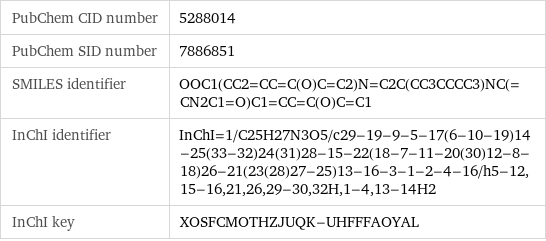Input interpretation

cp-coeleneterazine
Chemical names and formulas
![formula | C_25H_27N_3O_5 name | cp-coeleneterazine IUPAC name | (2S)-8-(cyclopentylmethyl)-2-hydroxy-6-(4-hydroxyphenyl)-2-[(4-hydroxyphenyl)methyl]-7, 8-dihydroimidazo[3, 2-a]pyrazin-3-one mass fractions | C (carbon) 66.8% | H (hydrogen) 6.05% | N (nitrogen) 9.35% | O (oxygen) 17.8%](../image_source/0b1e508809d955e58362b9b8394782a0.png)
formula | C_25H_27N_3O_5 name | cp-coeleneterazine IUPAC name | (2S)-8-(cyclopentylmethyl)-2-hydroxy-6-(4-hydroxyphenyl)-2-[(4-hydroxyphenyl)methyl]-7, 8-dihydroimidazo[3, 2-a]pyrazin-3-one mass fractions | C (carbon) 66.8% | H (hydrogen) 6.05% | N (nitrogen) 9.35% | O (oxygen) 17.8%
Lewis structure

Draw the Lewis structure of cp-coeleneterazine. Start by drawing the overall structure of the molecule, ignoring potential double and triple bonds: Count the total valence electrons of the carbon (n_C, val = 4), hydrogen (n_H, val = 1), nitrogen (n_N, val = 5), and oxygen (n_O, val = 6) atoms: 25 n_C, val + 27 n_H, val + 3 n_N, val + 5 n_O, val = 172 Calculate the number of electrons needed to completely fill the valence shells for carbon (n_C, full = 8), hydrogen (n_H, full = 2), nitrogen (n_N, full = 8), and oxygen (n_O, full = 8): 25 n_C, full + 27 n_H, full + 3 n_N, full + 5 n_O, full = 318 Subtracting these two numbers shows that 318 - 172 = 146 bonding electrons are needed. Each bond has two electrons, so in addition to the 64 bonds already present in the diagram add 9 bonds. To minimize formal charge carbon wants 4 bonds, nitrogen wants 3 bonds, and oxygen wants 2 bonds. Identify the atoms that want additional bonds and the number of electrons remaining on each atom: Fill in the 9 bonds by pairing electrons between adjacent highlighted atoms: Answer: | |
Basic properties

molar mass | 449.51 g/mol phase | solid (at STP)
Units

Hydrophobicity and permeability properties

predicted LogP hydrophobicity | 3.46 predicted LogS | -3.89
Basic drug properties

approval status | experimental | small molecule
Chemical identifiers

PubChem CID number | 5288014 PubChem SID number | 7886851 SMILES identifier | OOC1(CC2=CC=C(O)C=C2)N=C2C(CC3CCCC3)NC(=CN2C1=O)C1=CC=C(O)C=C1 InChI identifier | InChI=1/C25H27N3O5/c29-19-9-5-17(6-10-19)14-25(33-32)24(31)28-15-22(18-7-11-20(30)12-8-18)26-21(23(28)27-25)13-16-3-1-2-4-16/h5-12, 15-16, 21, 26, 29-30, 32H, 1-4, 13-14H2 InChI key | XOSFCMOTHZJUQK-UHFFFAOYAL